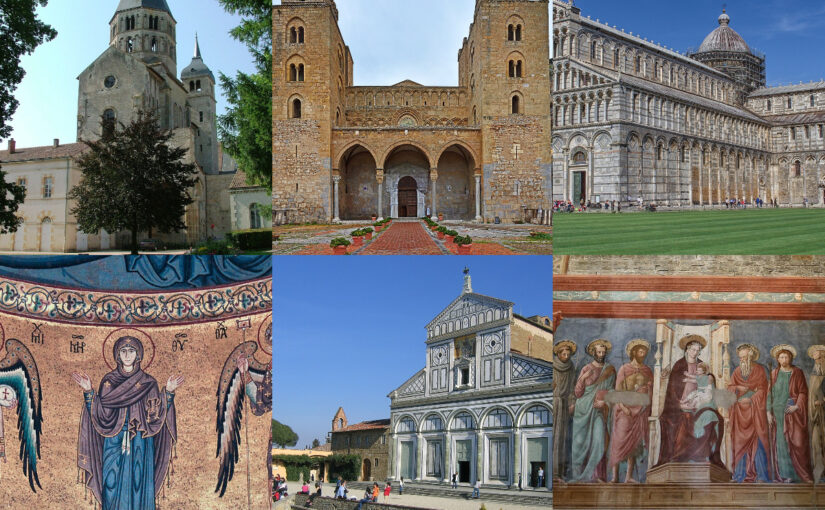Imagine a time when Europe emerged from centuries of upheaval, its people seeking solace in stone and spirit. The Romanesque era, spanning the 10th to 12th centuries, marked a profound architectural awakening across the Mediterranean. This was no mere building spree. It was a revival, a fervent reimagining of sacred spaces amid monastic zeal and societal rebirth. The term “Romanesque” itself nods to its roots, a nod to the ancient Roman techniques it borrowed and transformed. Rounded arches, sturdy vaults, and massive walls echoed the empire’s engineering prowess, yet these elements were infused with a distinctly Christian purpose, creating fortresses of faith that stood as beacons in a turbulent world.
Historical and Architectural Context
The Mediterranean heartlands of France, Spain, and Italy became hotbeds for grand church construction during these centuries. As feudal societies stabilized and trade routes reopened, resources flowed toward ambitious projects. Cities like Pisa, Cluny, and Santiago de Compostela saw cathedrals rise, often funded by wealthy patrons or burgeoning monastic orders. This surge was no accident. It coincided with the Cluniac reform movement, which emphasized disciplined monastic life and sparked a wave of abbey-building across the region.
Social and religious forces fueled this boom. Pilgrimage routes, such as the Camino de Santiago in Spain, demanded durable shelters for weary travelers. Monastic expansion, driven by orders like the Benedictines, turned remote valleys into spiritual powerhouses. Technologically, advances in masonry allowed for larger, more stable structures. Stone quarries buzzed with activity, and skilled artisans perfected techniques for cutting and fitting blocks without the need for earlier wooden frameworks.
Yet the architecture spoke to deeper needs. In an age of invasions and uncertainty, churches had to embody stability and divine protection. Thick stone walls, often several feet deep, provided literal fortification, while massive pillars grounded the structures like unyielding sentinels. Small windows, high and narrow, admitted just enough light to evoke mystery without compromising strength. These choices were deliberate, blending practicality with symbolism to create spaces that felt eternal and impregnable.
Key structural features defined the style. Rounded arches, inspired by Roman aqueducts, framed doorways and windows, distributing weight evenly. Barrel vaults, long cylindrical ceilings of stone, replaced fragile wooden roofs, allowing for wider interiors. Decorative arcading, rows of small arches along walls or facades, added rhythm and texture. Symmetry governed plans, with naves (central halls) flanked by aisles, leading to a prominent apse. The overall appearance was fortress-like, solid and grounded, a stark contrast to the ethereal heights of later eras.
Innovations abounded. Sculptural portals, richly carved entrances, became canvases for biblical tales. Crypts, underground chambers for relics, added layers of sanctity. Towers, whether bell or lantern types, punctuated skylines, calling communities to prayer and serving as landmarks for pilgrims.
Key Features and Regional Identity
Romanesque churches varied subtly across the Mediterranean, each region imprinting its own flavor while adhering to core principles. In Italy, the style leaned toward elegance, with lighter stone and intricate marble inlays, as seen in Tuscan examples. France favored robust, sculptural forms, often tied to monastic complexes. Spain’s versions incorporated Moorish influences, blending rounded arches with geometric patterns from Islamic architecture, especially in the north where Christian kingdoms pushed back against Muslim rule.
Local traditions and materials played pivotal roles. Italian builders drew on abundant marble, creating facades that gleamed under the sun. French stonemasons, working with coarser limestone, emphasized bold reliefs. In Spain, red sandstone lent a warm hue, and proximity to Islamic territories introduced motifs like interlacing arches. Yet unity prevailed. All shared the rounded arch, the emphasis on mass over height, and a sense of enclosed, introspective space.
Sculpture wove narrative art into the fabric of these buildings. Famous tympanums, semicircular panels above doors, depicted Last Judgments or Christ in Majesty, their figures twisted in expressive drama. Capitals atop columns burst with foliage, beasts, and moral tales, turning every surface into a lesson for the illiterate faithful. This integration was revolutionary, making churches not just shelters but storybooks in stone.
Notable Examples
Certain churches stand as timeless exemplars, their stones whispering of the era’s ingenuity.
Pisa Cathedral, Italy (begun 1064, Romanesque)
Pisa Cathedral, begun in 1064, anchors the Piazza dei Miracoli in Italy, a masterpiece of Tuscan Romanesque. Its layout follows a classic basilican plan, with a long nave leading to a domed crossing and apse. The façade captivates with tiers of arcades, white marble columns rising in harmonious layers, each level adorned with intricate carvings. Decorative elements, including bronze doors and geometric patterns, reflect Pisan wealth from maritime trade. This cathedral’s significance lies in its blend of functionality and beauty, influencing regional styles and symbolizing civic pride.
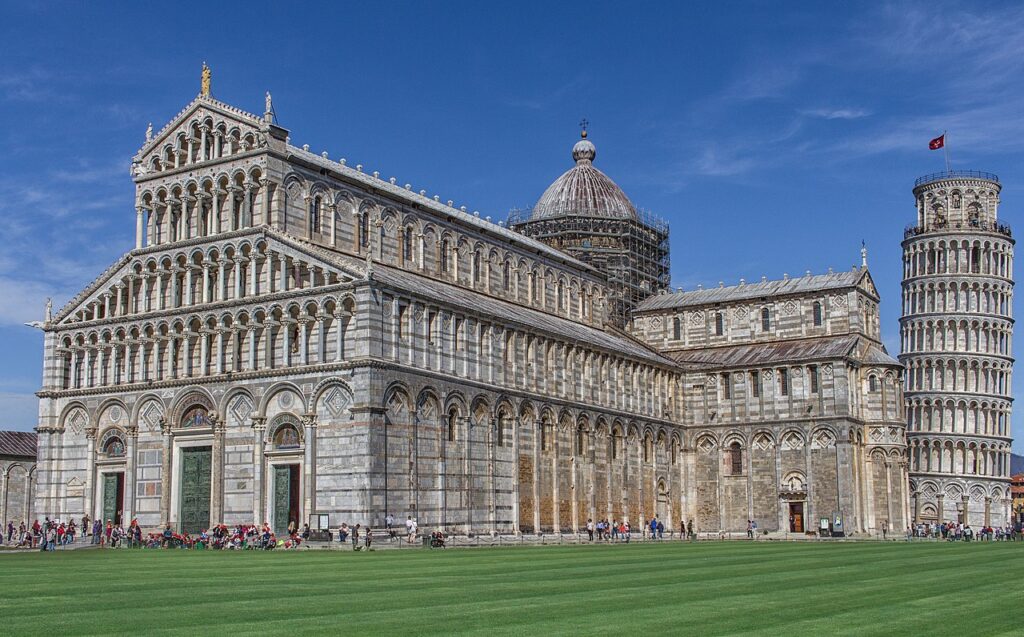
Cathedral of Cefalù, Sicily (begun 1131, Norman Romanesque)
The Cathedral of Cefalù in Sicily, started in 1131 under Norman rule, embodies a fortress-like exterior that belies its interior splendor. Twin towers flank the entrance, their massive forms evoking a defensive stronghold amid the island’s volatile history. Inside, golden mosaics shimmer, depicting Christ Pantocrator in the apse, a fusion of Byzantine artistry with Norman boldness. This blend of Mediterranean elements, from Arab-inspired pointed arches to Western solidity, highlights Sicily’s cultural crossroads, making Cefalù a testament to Norman ambition and artistic synthesis.
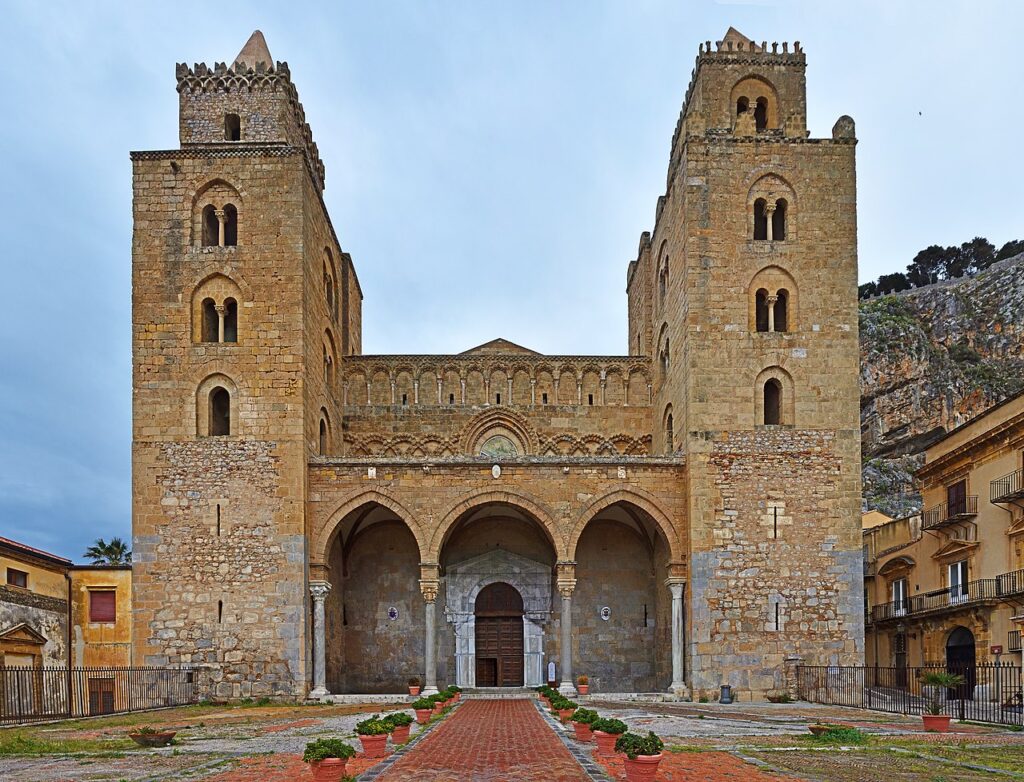
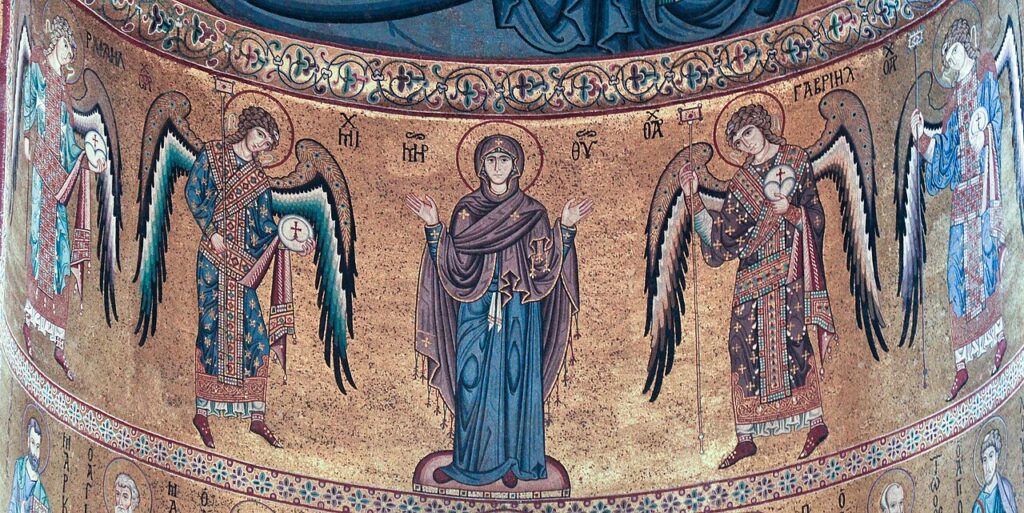
San Miniato al Monte, Florence (11th century, Romanesque)
San Miniato al Monte, perched above Florence since the 11th century, offers harmonious symmetry that feels almost mathematical in its precision. The façade features green and white marble in geometric motifs, with blind arcades and a central rose window creating a balanced, almost serene composition. Its panoramic position on a hilltop adds to the allure, inviting visitors to ascend for views of the Arno Valley. This church exemplifies Florentine Romanesque, where restraint and proportion foreshadow Renaissance ideals.
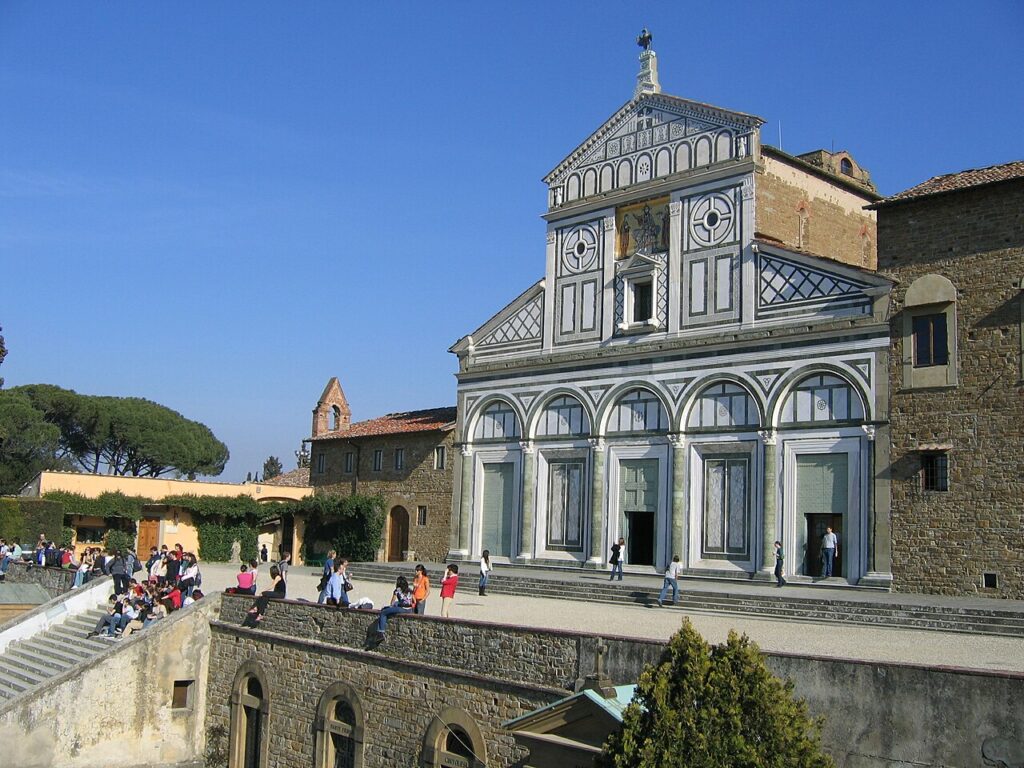
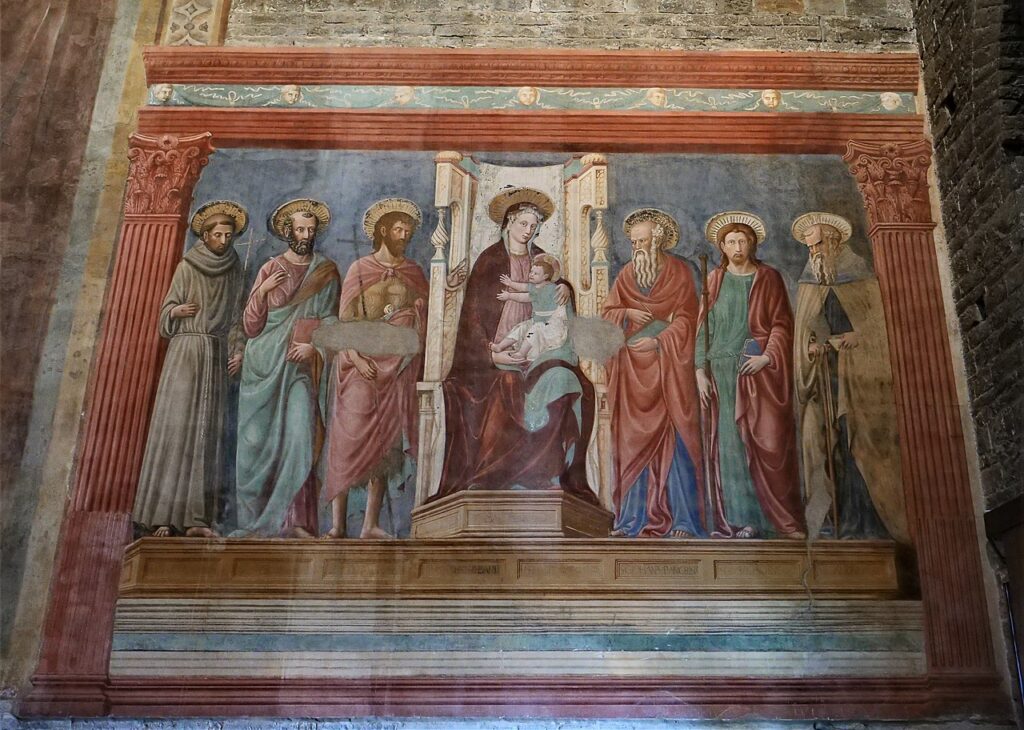
Abbey of Cluny (France)
Though mostly ruined today, the Abbey of Cluny in France was once the pinnacle of monastic Romanesque. Founded in the 10th century, it grew into a vast complex with multiple churches, cloisters, and living quarters, influencing hundreds of affiliated monasteries. Its epochal importance stems from the Cluniac order’s reforms, which emphasized liturgy and architecture as paths to divine order. Even in fragments, Cluny’s scale and innovations in vaulting underscore its role as a blueprint for European monasticism.
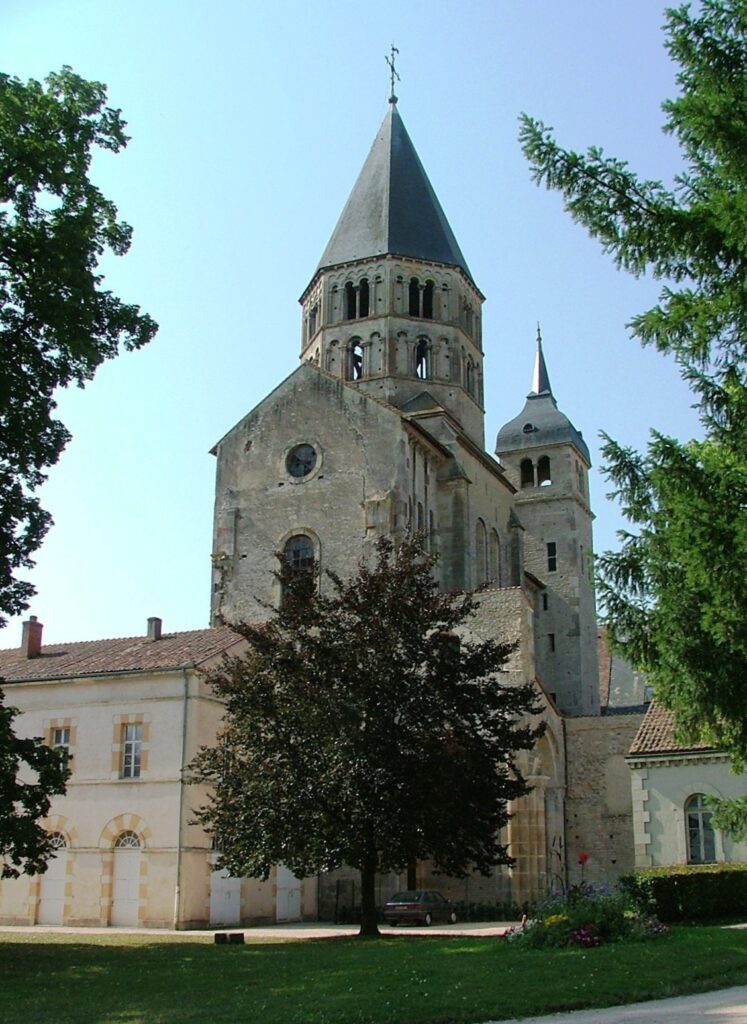
Cultural and Spiritual Impact
Romanesque churches were more than buildings. They served as community centers, where villagers gathered for markets, judgments, and festivals. As monastic hubs, they fostered scholarship, agriculture, and charity, anchoring rural life. Pilgrims flocked to them, drawn by relics and the promise of grace, turning routes into arteries of cultural exchange.
Step inside one, and the atmosphere envelops you. Heavy stone walls muffle the outside world, while subdued light filters through narrow windows, casting elongated shadows that heighten a sense of awe and refuge. The air feels thick with history, incense, and whispered prayers. This design connected worshipers to biblical stories through carved portals and capitals, guiding the eye and soul toward heavenly order. In an era of short lives and hard labors, these spaces offered tangible links to the divine, a stone embrace of eternity.
Legacy and Influence
Romanesque architecture laid the groundwork for the Gothic explosion, its rounded arches evolving into pointed ones, its vaults inspiring ribbed innovations. Yet its influence endures in the sturdy grace of Mediterranean landmarks. Travelers today can wander Pisa’s piazza or climb to San Miniato, feeling the pull of centuries-old craftsmanship. These churches remain valued as emblems of faith, art, and heritage, preserving stories of resilience and creativity that continue to inspire.
For those eager to delve deeper, consider exploring these sites in person or through virtual tours. They stand as invitations to connect with the past.
References and Suggested Readings:
- “Romanesque Architecture,” Britannica: https://www.britannica.com/art/Romanesque-architecture
- “Romanesque Art,” The Metropolitan Museum of Art: https://www.metmuseum.org/essays/romanesque-art
- “The Romanesque,” Rota do Românico: https://www.rotadoromanico.com/en/the-route/romanesque/
- “What is Romanesque Architecture?” Navilize: https://navilize.com/blog/what-is-romanesque-architecture/
- “Chapter 11: The Romanesque Period,” ARTS 101: https://cwi.pressbooks.pub/arts101draft/chapter/the-romanesque/
- “Route of Romanesque Art,” Tourisme Pyrénées-Méditerranée: https://www.tourisme-pyrenees-mediterranee.com/en/explorer/entrez-dans-lhistoire/route-de-lart-roman/
If our work has inspired you, helped you grow, or simply brought a little warmth to your day, consider supporting Thalysia.com with a small donation. Your contribution helps us continue exploring ancient landscapes, documenting local traditions, and celebrating the art of living well.
